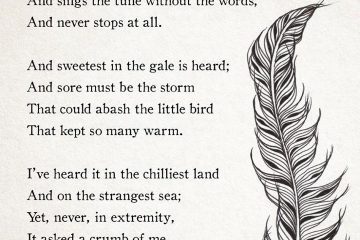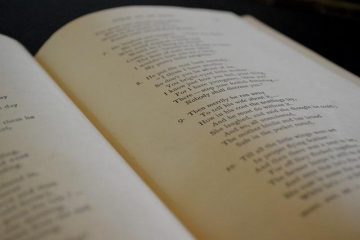Unveiling the Art of Poetry: Exploring Poem Elements
Poetry, often regarded as the language of the soul, weaves emotions and ideas into intricate tapestries of words. But what lies beneath the surface of these seemingly simple verses? Each poem is a carefully crafted work, enriched with elements that contribute to its unique charm and impact. From rhythm and rhyme to imagery and symbolism, these foundational components shape the reader’s experience and interpretation. In this exploration of poem elements, we will dive deep into the core aspects that define poetic works, uncovering how they function individually and harmoniously to evoke feelings, stir thoughts, and resonate across time and culture. Whether you are an aspiring poet or an avid reader, understanding these elements will enhance your appreciation of the art form and inspire you to find beauty in every line.Table of Contents
- Understanding the Core Elements of Poetry
- Exploring the Impact of Imagery and Symbolism
- The Role of Sound: Rhyme, Rhythm, and Meter
- Crafting Emotion Through Language and Tone
- Unlocking Meaning: The Importance of Theme and Structure
- Q&A
- To Conclude
Understanding the Core Elements of Poetry
Poetry is a tapestry woven from various threads, each contributing to its overall beauty and impact. At the heart of every poem, we encounter several core elements that define its structure and emotional resonance. These components include form, imagery, and theme, which collectively shape the poet’s message and engage the reader’s senses. Understanding these facets can deepen our appreciation of the craft and unlock the hidden layers within a poem.
Form refers to the physical structure of a poem: the arrangement of lines, stanzas, and overall length. It can range from a traditional sonnet, with its rigid rhyme scheme, to free verse that flows more like a conversation. The choice of form can significantly influence the poem’s rhythm and mood. Alongside form, imagery plays a critical role, employing vivid descriptions that evoke sensory experiences. Poets utilize figurative language—such as metaphors, similes, and personification—to create mental pictures that resonate with the audience, drawing them into the world of the poem.
Equally important is theme, which encapsulates the underlying message or central idea the poet wishes to convey. Themes can explore a vast array of human experiences, from love and loss to nature and identity, often inviting readers to reflect on their own lives. To illustrate how these elements interact, consider the following table that outlines examples of form, imagery, and theme:
| Element | Example |
|---|---|
| Form | Sonnet |
| Imagery | Whispers of the falling leaves |
| Theme | The passage of time |


Exploring the Impact of Imagery and Symbolism
Imagery and symbolism are potent tools in poetry, acting as gateways to deeper understanding and emotional resonance. Through vivid imagery, poets paint pictures that allow readers to visualize their thoughts and feelings. This visual representation not only evokes sensory responses but also bridges personal experiences with universal themes. For instance, the use of nature imagery—like the budding of spring flowers or the desolation of winter—can encapsulate ideas of renewal, hope, loss, and despair, making the poem relatable and evocative.
Symbolism layers meaning into poetry, infusing everyday objects and actions with profound significance. A simple rose, for example, may symbolize love and beauty, yet can also represent pain due to its thorns. This duality allows poets to explore complex emotions and ideas without overt explanation, inviting readers into a richer interpretative experience. When readers decipher these symbols, they engage in a dialogue with the text, uncovering nuances that resonate with their own lives.
The interplay of imagery and symbolism enhances the effectiveness of poetic expression and promotes profound engagement. Here’s a simple comparison of popular symbols and their meanings in poetry:
| Symbol | Common Interpretation |
|---|---|
| Water | Life, purification, change |
| Fire | Destruction, passion, transformation |
| Birds | Freedom, hope, transcendence |
| Seasons | Cycles of life, change, growth |
Understanding the dynamic between imagery and symbolism enables readers to appreciate how poets create layers of meaning. This depth inspires not only a deeper connection with the poem but also encourages personal reflection, making each reading a unique experience.


The Role of Sound: Rhyme, Rhythm, and Meter
Sound plays a crucial role in poetry, transforming simple verses into rhythmic landscapes that linger in the listener’s mind. When poets carefully choose their words and structure, they create an auditory experience that enhances the poem’s emotional weight. Elements such as rhyme, rhythm, and meter work in harmony to generate a musicality that invites readers to engage on a deeper level. For instance:
- Rhyme: This technique connects lines and thoughts, giving a sense of closure or unexpected turns. It can create a playful or serious tone depending on its application.
- Rhythm: The pace and flow of poetry—established through stressed and unstressed syllables—shapeshifts the reading experience, allowing the poem to mirror its themes effectively.
- Meter: Often defined as the structured pattern of syllables in a line, meter serves as the backbone of a poem, allowing for a balance between regularity and spontaneity.
To illustrate these sound elements, consider how a familiar nursery rhyme enchants both children and adults alike. Each line’s end echoes with a melodic ring, while the rhythmic pattern lulls the listener, making the experience memorable. Yet, it’s not just the cheerful tones that resonate; the underlying meter gives stability and predictability which can be comforting. In contrast, free verse poetry often forgoes these constraints, allowing poets the freedom to experiment with sound, creating innovative rhythms that can evoke surprise or challenge traditional perceptions.
Examining these sound elements through a comparative lens, we can create a table that highlights the differences between structured and free forms in poetry:
| Element | Structured Poetry | Free Verse Poetry |
|---|---|---|
| Rhyme | Consistent, often end rhyme | Irregular, spontaneous |
| Rhythm | Predictable patterns | Varied, fluctuating |
| Meter | Defined syllabic patterns | No fixed meter |
Understanding the intricate dance of rhyme, rhythm, and meter enriches our appreciation for poetry. These sound elements not only enhance the aesthetic quality of a poem but also serve as pivotal tools for conveying emotion and meaning, ultimately helping to forge a connection between poet and reader.


Crafting Emotion Through Language and Tone
Language is a powerful tool that enables poets to evoke feelings and conjure vivid imagery, allowing readers to connect with the poem on a deeper level. The choice of words, their connotations, and the rhythm of the lines play pivotal roles in shaping emotional responses. For example, vivid adjectives can paint pictures, while action verbs breathe life into the imagery. Consider the impact of metaphors and similes; they create associations that resonate deeply, inviting readers to explore complex meanings and feelings within a few lines. The use of alliteration can add a musical quality that enhances the emotional atmosphere of the poem.
The tone of a poem can shift dramatically depending on the diction chosen by the poet. A reflective tone may employ softer, more contemplative words, whereas a confrontational tone might call for harsher, more abrasive language. This tonal variation can indicate the speaker’s emotional state, influencing how the audience interprets the message. Consider how a subtle change in tone can alter the reader’s perception of a theme, as demonstrated by utilizing irony or sarcasm to highlight sadness beneath humor, or layering joy over sorrow to mirror the complexities of human experience.
Furthermore, the structural elements of a poem—such as line breaks, stanza organization, and punctuation—play a crucial role in guiding emotion and engagement. Line breaks can create pauses that emphasize particular phrases or ideas, influencing the pacing and flow of the piece. For instance:
| Poetic Element | Emotional Impact |
|---|---|
| Imagery | Evokes sensory experiences that resonate emotionally. |
| Diction | Shapes the overall tone and conveys subtle nuances. |
| Structure | Controls rhythm and pacing, guiding emotional responses. |
By skillfully intertwining these elements, poets can create a rich emotional tapestry that resonates with readers, ensuring the poem leaves a lasting impression long after the last line is read.


Unlocking Meaning: The Importance of Theme and Structure
Within the realm of poetry, the interplay between theme and structure profoundly shapes a poem’s essence and resonates with readers on multiple levels. Theme refers to the underlying message or central idea that the poet aims to convey, encapsulating emotions, experiences, or societal observations. Meanwhile, structure involves the organization of the poem—the arrangement of lines, stanzas, rhyme schemes, and meter—that dictates how the poem flows and how the theme unfolds. Together, these elements weave a tapestry that captures and holds the reader’s attention, inviting deeper reflection.
Recognizing and analyzing the theme allows readers to engage more intimately with the text. Thematic elements can vary widely, with examples including:
- Love – Exploring romantic relationships and emotional connections.
- Nature – Examining the beauty and brutality of the natural world.
- Identity - Investigating personal and cultural self-representation.
By identifying the theme, readers can unlock an understanding of the poem’s heart and motives.
Structure plays an equally critical role in how a poem communicates its theme. For instance, shorter stanzas might evoke a sense of urgency or emotion, while regular rhyme schemes can create a musicality that enhances the theme’s emotional weight. Below is a simple comparison of how different structures can influence thematic interpretation:
| Structure Type | Thematic Impact |
|---|---|
| Fixed Rhymes | Suggests harmony or inevitability. |
| Free Verse | Indicates freedom or chaos in emotions. |
| Short Lines | Cuts through ideas quickly, heightening emotional tension. |
Ultimately, the delicate balance of theme and structure enriches the poetic experience. By engaging with both elements, readers can derive a more profound and layered understanding of each work, revealing the intricate artistry that poets employ to ignite thought, evoke feeling, and inspire transformation.
Q&A
Exploring Poem Elements: A Q&A Guide
Q1: What are the fundamental elements of a poem?
A1: The fundamental elements of a poem include structure, sound, imagery, theme, and emotion. Each of these components contributes to the overall experience of the poem, blending to create a piece that resonates with the reader. The structure can refer to the form and layout, while sound pertains to rhythm and rhyme. Imagery evokes visual responses, and themes explore the underlying messages and emotions conveyed.Q2: How does the structure of a poem influence its meaning?
A2: The structure of a poem, including its stanza arrangement, line length, and overall format, significantly impacts its meaning. For example, a tight, consistent structure may evoke a feeling of order, while a free verse poem can impart a sense of spontaneity. By manipulating form, poets can heighten emotional responses or emphasize particular themes, guiding readers through their intended experience.Q3: Why is sound important in poetry?
A3: Sound plays a critical role in poetry because it enhances the auditory experience of reading. Elements like rhyme, alliteration, assonance, and rhythm contribute to the musicality of a poem, making it more engaging. These sound patterns can create a rhythm that complements the poem’s mood, helping to reinforce its themes and emotions, thereby making it memorable.Q4: What is imagery, and why is it significant in poetry?
A4: Imagery refers to the use of vivid and descriptive language that appeals to the senses, helping readers visualize scenes and emotions. It’s significant because it creates a more immersive experience, allowing readers to connect deeply with the poet’s thoughts and feelings. By crafting powerful images, poets can transport readers to different settings and evoke strong emotional reactions.Q5: How can understanding the theme enhance the reading experience of a poem?
A5: Understanding the theme of a poem allows readers to grasp its deeper meanings and insights. Themes often explore universal concepts such as love, loss, nature, and identity. When readers identify these themes, they can appreciate the nuances of the poem and relate personal experiences, thereby enriching their overall reading experience.Q6: Can emotion be considered an element of poetry? If so, how?
A6: Absolutely! Emotion is not only an element but the heart of poetry. It encompasses the feelings the poet expresses and the emotions evoked in the reader. Poems often serve as a conduit for deep personal feelings, whether joy, sorrow, anger, or nostalgia. Recognizing and connecting with these emotions can profoundly influence how a poem is interpreted and appreciated.Q7: How does a poet balance these elements to create a cohesive work?
A7: A poet balances these elements by carefully considering how each component interacts. They might start with a central theme and then choose a structure that complements it, select imagery that reinforces the theme, and employ sound devices that enhance emotional impact. This intricate dance between elements requires skill and intention, resulting in a cohesive and compelling poem that resonates effectively with readers.These questions and answers provide a foundational understanding of poem elements, inviting readers to delve deeper and appreciate the artistry behind poetry. Whether you’re a novice poet or an avid reader, recognizing these elements will enhance your experience and appreciation for the craft!




0 Comments